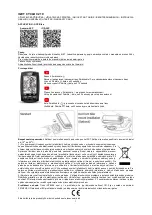
98 •
O W N E R ’ S M A N U A L
on bicycle components, causing them to fatigue
prematurely. Components suffering from stress
fatigue can fail suddenly and catastrophically,
causing loss of control and fall.
Nothing lasts forever, including your IDEAL bicycle.
When the useful life of your bike or its components is
over, continued use is hazardous. Every bicycle and
its component parts have a finite, limited useful life.
The length of that life will vary with the construction
and materials used in the frame and components; the
maintenance and care the frame and components
receive over their life; and the type and amount
of use to which the frame and components are
subjected. Use in competitive events, trick riding,
ramp riding, jumping, aggressive riding, riding on
severe terrain, riding in severe climates, riding
with heavy loads, commercial activities and other
types of non-standard use can dramatically shorten
the life of the frame and components. Any one or
a combination of these conditions may result in
an unpredictable failure. All aspects of use being
identical, lightweight bicycles and their components
will usually have a shorter life than heavier bicycles
and their components. In selecting a lightweight
bicycle or components you are making a tradeoff,
favoring the higher performance that comes with
lighter weight over longevity. So, If you choose
lightweight, high performance equipment, be sure to
have it inspected frequently.
Metals are subject to fatigue. With enough cycles
of use, at high enough loads, metals will eventually
develop cracks that lead to failure. Fatigue is the
term used to describe accumulated damage to a part
caused by repeated loading. Fatigue has nothing to
do with time or age. A bicycle parked in a garage
does not fatigue. Fatigue happens only through use.
On a microscopic level, a crack forms in a highly
stressed area. As the load is repeatedly applied,
the crack grows. At some point the crack becomes
visible to the naked eye. Eventually it becomes so
large that the part is too weak to carry the load that
it could carry without the crack. At that point there
can be a complete and immediate failure of the part.
A part so strong that its fatigue life is nearly infinite,
is possible to be designed and manufactured. But
this requires a lot of material and thus weight. Any
structure that must be light and strong will have a
finite fatigue life. Airplanes, cars, motorcycles they
all have parts with finite fatigue lives. If you wanted
a bicycle with an infinite fatigue life, it would weigh
far more than any bicycle sold today.
A few simple rules about wear, tear, and fatigue
follow:
•
Once a crack starts, it can grow and it can grow
fast. All cracks are potentially dangerous and will
only become more dangerous; never less. So if you
find crack, replace the part.
•
Cracks grow quicker when they are in a corrosive
environment. Clean and lubricate your bicycle,
protect it from salt and remove any salt as soon as
possible. Salt is a slow death for all parts actually;
even without cracks, it is very common that salt
will get through small surface scratches that have
nothing to do with strength & fatigue.
•
Stains and discoloration may occur near cracks. So
such a staining is a warning sign that a crack exists.
Therefore, you must inspect and investigate any
staining to see if it is associated with a crack.
•
Significant scratches, dents or scoring are starting
points for cracks. Such areas facilitate the
concentration and amplification of stresses. They
must be immediately repaired or the complete part
must be replaced.
•
Some cracks make a creaking noise while riding.
Such noises may thus be a warning signal. A
well-maintained bicycle must be quiet and free of
creaks and squeaks. Whatever causes noise, must
be fixed promptly and permanently.
In most cases a fatigue crack is not a defect. It is
a sign that the part has been worn out, a sign the
part has reached the end of its useful life. When car
tires wear down to the point that the tread bars are
contacting the road, those tires are not defective
but worn out. When a metal part shows a fatigue
crack, it is worn out and the crack says “time for
replacement.”
Fatigue is not a perfectly predictable science.
Factors that shorten product life:
•
Hard, harsh riding style
•
“Hits,” crashes, jumps, other “shots” to bike
•
High mileage
•
Higher body weight
•
Stronger, more fit, more aggressive rider
ideal owners manual english_5_2014.indd 98
4/30/14 13:38
Содержание AXION
Страница 39: ...40 F A H R R A D B E T R I E B S A N L E I T U N G ideal owners manual german_5_2014 indd 40 4 30 14 13 37 ...
Страница 75: ...76 O W N E R S M A N U A L ideal owners manual english_5_2014 indd 76 4 30 14 13 38 ...
Страница 109: ...NOTES ideal owners manual english_5_2014 indd 110 4 30 14 13 38 ...














































